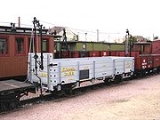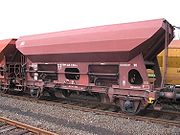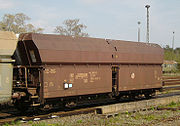
Open wagon
Encyclopedia

International Union of Railways
The UIC , or International Union of Railways, is an international rail transport industry body.- Brief history :The railways of Europe originated as separate concerns. There were many border changes after World War I and the Treaty of Versailles. Colonial railways were the responsibility of the...
(UIC) distinguishes between ordinary wagons (Class
UIC classification of goods wagons
This list contains the UIC classification of goods wagons and their meanings. The description is made up of a class letter and usually several code letters ....
E/UIC-type 5) and special wagons (F/6). Open wagons often form a significant part of a railway company's goods wagon fleet; for example, forming just under 40% of the Deutsche Bahn
Deutsche Bahn
Deutsche Bahn AG is the German national railway company, a private joint stock company . Headquartered in Berlin, it came into existence in 1994 as the successor to the former state railways of Germany, the Deutsche Bundesbahn of West Germany and the Deutsche Reichsbahn of East Germany...
's total goods wagon stock in Germany.
UIC standard goods wagons


International Union of Railways
The UIC , or International Union of Railways, is an international rail transport industry body.- Brief history :The railways of Europe originated as separate concerns. There were many border changes after World War I and the Treaty of Versailles. Colonial railways were the responsibility of the...
. In addition to open wagons the table also shows wagons with opening roofs (Class T), whose design is based on open wagons.
| Norm | UIC 571-1: Ordinary class two axles |
UIC 571-2: Ordinary class four axles |
UIC 571-3: Special class |
|||||
|---|---|---|---|---|---|---|---|---|
| Class | Type 1 "French" |
Type 2 "German" |
Wagon with sliding roof four axles |
Hopper wagon two axles |
Saddle-bottomed wagon four axles |
|||
| without roof | with roof | without roof | with roof | |||||
| Class UIC classification of goods wagons This list contains the UIC classification of goods wagons and their meanings. The description is made up of a class letter and usually several code letters .... |
Es | Ea(o)s | Taems to 1979: Taes |
Fcs | Tds | Fals | Tals | |
| Axle base | 4.85 m | 5.40 m | − | 6.00 m | − | |||
| Bogie pivot pitch | − | 9.00 m | − | 7.50 m | ||||
| Length over buffers | 9.04 m | 10.00 m | 14.04 m | 9.64 m | 12.54 m | |||
| Loading length, min. | 7.79 m | 8.76 m | 12.71 m | 12.40 m | − | − | ||
| Loading area, ca. | 22 m² | 24 m² | 35 m² | 33 m² | − | − | ||
| Loading volume, ca. | 36 m³ | 36 m³ | 71 m³ | 74 m³ | 40 m³ | 38 m³ | 75 m³ | 72 m³ |
| Unladen weight, max. | … | 12.5 t | 22.0 t | 24.0 t | 13.0 t | 13.5 t | 15.0 t | 15.5 t |
| Doors per side | 2 | 1 | 2 | 1 | − | − | ||
| Door width | … | 1.80 m | 1.80 m | 4.00 m | − | − | ||
Class E - Ordinary open high-sided wagons


Coal
Coal is a combustible black or brownish-black sedimentary rock usually occurring in rock strata in layers or veins called coal beds or coal seams. The harder forms, such as anthracite coal, can be regarded as metamorphic rock because of later exposure to elevated temperature and pressure...
, scrap
Scrap
Scrap is a term used to describe recyclable and other materials left over from every manner of product consumption, such as parts of vehicles, building supplies, and surplus materials. Unlike waste, scrap has significant monetary value...
, steel
Steel
Steel is an alloy that consists mostly of iron and has a carbon content between 0.2% and 2.1% by weight, depending on the grade. Carbon is the most common alloying material for iron, but various other alloying elements are used, such as manganese, chromium, vanadium, and tungsten...
, wood
Wood
Wood is a hard, fibrous tissue found in many trees. It has been used for hundreds of thousands of years for both fuel and as a construction material. It is an organic material, a natural composite of cellulose fibers embedded in a matrix of lignin which resists compression...
and paper
Paper
Paper is a thin material mainly used for writing upon, printing upon, drawing or for packaging. It is produced by pressing together moist fibers, typically cellulose pulp derived from wood, rags or grasses, and drying them into flexible sheets....
. The majority of wagons have folding sides and end walls, otherwise they are given the letters l (fixed sides) or o (fixed end walls). Wagons may have one or two folding end walls.
Steel rings enable ropes, nets or covers to be attached to secure the load.
Some of these wagons can also be completely tipped over, in other words, at certain places they can be lifted up and emptied by being turned about their longitudinal axis. This requires a very robust underframe. This type of unloading is particularly widespread in the US in the transportation of bulk goods; the wagons being fitted with rotatable couplings so that they do not have to be individually uncoupled.
In 1998 the DB
Deutsche Bahn
Deutsche Bahn AG is the German national railway company, a private joint stock company . Headquartered in Berlin, it came into existence in 1994 as the successor to the former state railways of Germany, the Deutsche Bundesbahn of West Germany and the Deutsche Reichsbahn of East Germany...
had about 16,000 four-axle Class E wagons. They have increasingly retired their twin-axled E wagons since the 1990s and they are now rarely seen.
Class F - Special open high-sided wagons

- Side-tipping wagons (box tip, trough-tip or side-tip wagon),
- Bucket wagon, other open wagons without side doors
- some East German wagons with steel floors were incorrectly grouped in this class
In 1998 the Deutsche Bahn
Deutsche Bahn
Deutsche Bahn AG is the German national railway company, a private joint stock company . Headquartered in Berlin, it came into existence in 1994 as the successor to the former state railways of Germany, the Deutsche Bundesbahn of West Germany and the Deutsche Reichsbahn of East Germany...
had about 12,000 hopper wagons, 10,000 saddle-bottomed wagons and 1,000 side-tipping wagons. In addition to hopper and saddle-bottomed wagons there were also wagons with opening roofs.
Typical loads for these wagons are all sorts of bulk goods, like coal, coke, ore, sand or gravel. Because bulk goods are often moved in large quantities, these wagons are frequently used in so-called unit or block trains
Unit train
A unit train, also called a block train, is a railway train in which all the cars making it up are shipped from the same origin to the same destination, without being split up or stored en route...
that only comprise one type of wagon and only shift one type of product from the dispatcher to the recipient.
Hopper wagons
Hopper wagons can only be unloaded by gravity with no external assistance and are therefore also classed as self-discharging wagons. The majority may be filled, when at rail or road level, by high-level discharge chutes (whose ends are more than 70 cm above the top of the rails) or conveyor belts. Because a controlled amount of the load can be discharged at any place the wagons may be sent anywhere and are even used individually. Railway companies also use hoppers as departmental wagons in maintenance of way trains for ballasting the track.Since the 1990s there has been a trend for new hopper wagons to be built as bogie wagons which have not yet been standardised by the UIC.
Saddle-bottomed wagons

Gable
A gable is the generally triangular portion of a wall between the edges of a sloping roof. The shape of the gable and how it is detailed depends on the structural system being used and aesthetic concerns. Thus the type of roof enclosing the volume dictates the shape of the gable...
. The discharging chutes on either side are relatively high up. These wagons are frequently seen in unit trains for transporting bulk goods such as coal
Coal
Coal is a combustible black or brownish-black sedimentary rock usually occurring in rock strata in layers or veins called coal beds or coal seams. The harder forms, such as anthracite coal, can be regarded as metamorphic rock because of later exposure to elevated temperature and pressure...
or mineral ore
Ore
An ore is a type of rock that contains minerals with important elements including metals. The ores are extracted through mining; these are then refined to extract the valuable element....
from mines or ports to steelworks or power stations.
The most modern type of four axle saddle-bottomed wagon in the DB is the four axle Falns 121 with a loading volume of 90 m³. It was built from 1992 in several batches. By February 2008 another 100 of these wagons were to have been delivered to the DB and another 300 by 2010. These latest wagons will have an axle load
Axle load
The axle load of a wheeled vehicle is the total weight felt by the roadway for all wheels connected to a given axle. Viewed another way, it is the fraction of total vehicle weight resting on a given axle...
of 23.5 t and an unladen weight of no more than 24.5 t, resulting in a load limit of 69.5 t.
Side-tipping wagons
Side-tipping wagons have hydraulic, pneumatic or electric tipping equipmentTipping
Tipping may refer to:* Paying a gratuity for services rendered* Giving information*Cow tipping, a rumored activity involving pushing over a sleeping cow*Fly-tipping, British term for illegally dumping waste...
, that enables the wagon body to be lifted on one side. Depending on the design, they may be tipped to both sides or just one side only. In order to prevent wagons from falling over during the tipping operation, some are equipped with track pinch bars with which they can be securely anchored to the trackbed. These wagons are often seen in unit trains being used to remove excavated material from major construction sites.
See also
- Gondola (rail)Gondola (rail)In railroad terminology, a gondola is an open-top type of rolling stock that is used for carrying loose bulk materials. Because of its low side walls, gondolas are used to carry either very dense material, such as steel plates or coils, or bulky items such as prefabricated pieces of rail...
- US open wagons - German state railway normsGerman state railway normsIn German railway engineering, norms are standards for the design and production of railway vehicles.In the 1880s and 1890s, Prussian norms were developed for the locomotives, tenders and wagons of the Prussian state railways under the direction of the railway director responsible for railway...
- early standards for the railways of states within the German EmpireGerman EmpireThe German Empire refers to Germany during the "Second Reich" period from the unification of Germany and proclamation of Wilhelm I as German Emperor on 18 January 1871, to 1918, when it became a federal republic after defeat in World War I and the abdication of the Emperor, Wilhelm II.The German... - VerbandsbauartVerbandsbauartThe German term Verbandsbauart describes both a type of goods wagon as well as a type of tram.In order to standardise the goods wagons classes of the various German state railways , the German State Railway Wagon Association issued regulations...
- standard wagons of the German State Railway Wagon AssociationGerman State Railway Wagon AssociationThe German State Railway Wagon Association was an association of the German state railways Länderbahnen founded in 1909. The purpose of the association was to guarantee the unrestricted exchange of goods wagons between the member railway administrations... - AustauschbauartAustauschbauartThe so-called Austauschbauart wagons were German railway vehicles produced from the late 1920s onwards which had common components built to agreed standards.-Origin of the concept:...
- standard wagons with interchangeable parts - KriegsbauartKriegsbauartThe German term Kriegsbauart refers to railway goods wagon classes that were developed during the Second World War for the Deutsche Reichsbahn. The start of the war was an arbitrary dividing line for the classification of goods wagons, and did not represent any technological change...
- German wartime wagons - Reko-Güterwagen - East German post-war wagons
- German railway wagon classesGerman railway wagon classesThe system of German railway wagon classes was introduced in Germany in 1902 and 1905 by the Prussian state railways based on their system of norms, and was soon taken up by the other state railways . On the formation of the Deutsche Reichsbahn, the system became mandatory across the whole of...
Sources
- Gerd Wolff: Die offenen Güterwagen der Regelbauart. Güterwagen-Lexikon DB. EK-Verlag, Freiburg (1991) ISBN 3-88255-649-8
- Gerd Wolff: Die zweiachsigen Selbstentladewagen. Güterwagen-Lexikon DB. EK-Verlag, Freiburg (1993) ISBN 3-88255-657-9
- Gerd Wolff: Die vierachsigen Selbstentladewagen / Die Staubbehälterwagen. Güterwagen-Lexikon DB. EK-Verlag, Freiburg (1994) ISBN 3-88255-658-7
- Behrends H et al.: Güterwagen-Archiv (Band 2), Transpress VEB Verlag für Verkehrswesen, Berlin 1989.
- Carstens S: Die Güterwagen der DB AG, MIBA-Verlang, Nürnberg 1998.
- Carstens S et al.: Güterwagen (Band 3 und 4), MIBA-Verlag, Nürnberg 2003.

